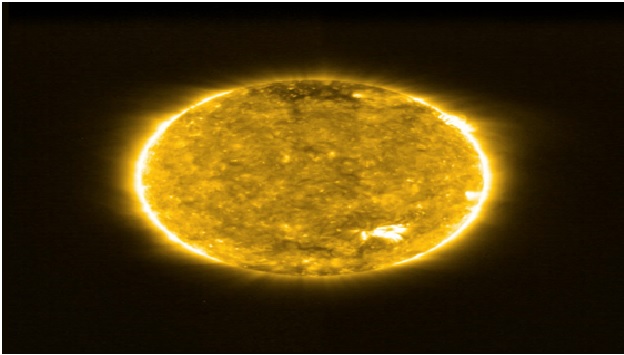Best Image of the Sun Captured by Solar Orbiter Spacecraft
The newest photographs from the Solar Orbiter reveal unprecedented detail of the whole Sun. They were taken on March 7, 2022, when the spacecraft passed between the Earth and the Sun.The Extreme Ultraviolet Imager (EUI) took one of the photographs, which is the highest resolution image of the Sun’s complete disc and outer atmosphere, the corona, ever taken.

Figure 1: EUI photograph of the sun
Figure 1 shows that the photographs were collected while Solar Orbiter was halfway between our planet and its parent star, at a distance of around 75 million kilometres. EUI’s high-resolution telescope captures photos with such high spatial resolution that a mosaic of 25 separate photographs is required to cover the full Sun at such a close distance.
Because each tile takes around 10 minutes, including the time for the spacecraft to point from one section to the next, the whole picture was obtained over a period of more than four hours, taken one after the other.
In total, the final image contains more than 83 million pixels in a 9148 x 9112-pixel grid. For comparison, this image has a resolution that is ten times better than what a 4K TV screen can display. [1]
EUI images the Sun at a wavelength of 17 nanometres, in the extreme ultraviolet region of the electromagnetic spectrum. This reveals the Sun’s upper atmosphere, the corona, which has a temperature of around a million degrees Celsius.
At the 2 o’clock (near the image of the Earth for scale) and 8 o’clock positions on the edges of the Sun, dark filaments can be seen projecting away from the surface. These ‘prominences’ are prone to erupt, throwing huge quantities of coronal gas into space and creating ‘space weather’ storms.
In addition to EUI, the SPICE instrument was also recording data during the crossing. These too needed to be pieced together as a mosaic.
SPICE is designed to trace the layers in the Sun’s atmosphere from the corona, down to a layer known as the chromosphere, getting closer to the surface. The instrument does this by looking at the different wavelengths of extreme ultraviolet light that come from different atoms. [2]
The images were captured on March 7, at the precise point that the spacecraft crossed the Sun-Earth line, allowing astronomers to line up the images with those captured by Earth based instruments, making it easy to compare results from various instruments and observatories in the future. The Solar Orbiter is currently within the orbit of Mercury, capturing images of the Sun and studying solar wind. [3]
References:
- https://scitechdaily.com/solar-orbiter-spacecraft-captures-the-full-sun-in-unprecedented-detail/
- https://www.esa.int/Science_Exploration/Space_Science/Solar_Orbiter/Zooming_into_the_Sun_with_Solar_Orbiter
- https://www.news9live.com/science/esas-solar-orbiter-captures-most-detailed-image-ever-of-suns-full-disc-and-corona-160938?infinitescroll=1
Cite this article:
Sri Vasagi K (2022), Best Image of the Sun Captured by Solar Orbiter Spacecraft, Anatechmaz, pp. 322

